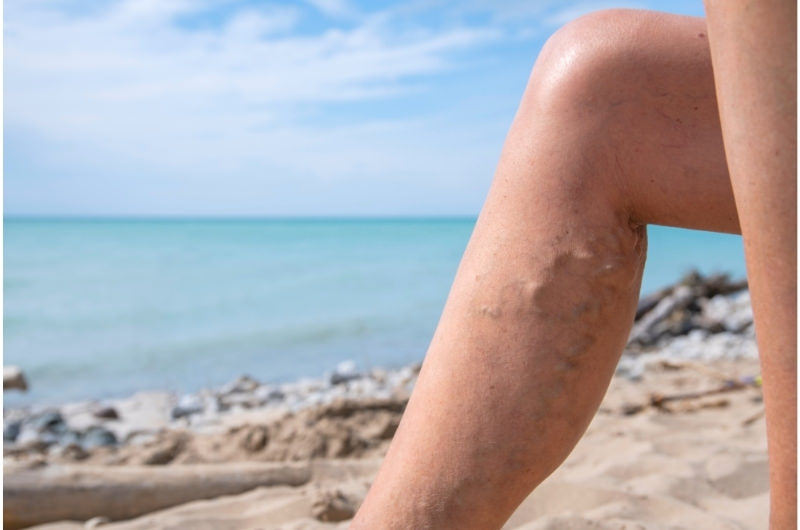About 20% of the population in the United States suffers from venous disease in some form. It is one of the leading causes of your veins becoming more visible. Some benign reasons which may cause visible veins are exercise, pale skin, age, and pregnancy. Conditions such as DVT and venous reflux diseases also cause visible veins. Symptoms like varicose veins can cause severe pain, strokes, and even cardiac arrest. Therefore, it is crucial to be mindful of both types of causations.
Some people enjoy how visible veins on the arms and legs look and consider it an indication of being in great shape and having good fitness levels.
As you get fitter with exercise, your muscles get more defined, and there is subcutaneous fat loss as well. Both of these reasons cause your veins to be visible even more.
Some others think that it may be a cause for an underlying disease. For example, visible veins can also be harmful if caused by blood pooling or venous reflux diseases.
Let’s explore the causes, treatments, and prevention of visible veins through your skin.
Common reasons for veins to show more
Let’s first learn about the normal and harmless causes of veins visible through your skin. Visible veins are considered a normal occurrence in the conditions mentioned below.
1. Exercise
The bulging seen in your veins after a strenuous activity like exercise is a normal physiological response. It occurs due to a rise in arterial blood pressure.
Your muscles harden and swell during and after a good workout. As a result, your veins are pushed to the skin surface and become more visible.
2. Skin color
People with lighter skin color or individuals born with porcelain or translucent skin can have more visible veins. Translucent skin allows increased light to pass through the skin and makes hidden structures like veins more visible.
Translucent or pale skin occurs in albinism, Ehlers-Danlos syndrome, and vitiligo.
3. Age
With increased age, the skin becomes thinner and loses its elasticity. As a result, a person’s veins on the hands can especially become pronounced as they get older.
With age, blood tends to pool in the veins for a long time which causes it to bulge even more.
4. Weather
Veins are dilated for increased blood flow in hot weather. As we tend to spend more time outdoors in summers, the high temperatures and increased physical activities outdoors combine to make your veins protrude more.
5. Pregnancy
Pregnancy brings hormonal changes, weight gain, and increased blood volume.
Many women who have never had visible veins before notice spider veins and varicose veins as their pregnancy progresses.
Spider veins differ from varicose veins in that they appear smaller and thinner. They are mostly red, sometimes blue or purple, often called thread veins as well. These veins disappear postpartum.
Harmful factors related to visible veins
Now let us understand the causes of pronounced and prominent veins that require more medical attention.
1. Bodyweight
Being overweight is a major contributing factor to varicose veins.
Extra body weight puts more stress on the joints and valves in the veins of your lower limb. When the valves weaken, it can cause backflow of blood, and it can collect in the vein causing it to bulge.
On the other hand, veins are visible on the hands and arms of underweight people because of reduced body fat percentage.
2. Varicose veins
Varicose veins occur due to a malfunctioning of the valves in your legs. The failing, one-directional valves allow blood to flow backward, so the veins get engorged with blood, and it may appear swollen and have a zigzag pattern.
These enlarged veins in the leg sometimes have a purplish or bluish appearance.
3. Chronic venous insufficiency (CVI) / Venous reflux disease
CVI is characterized by swelling in the lower leg, pain, heaviness, skin changes, itchiness, and varicose veins. It occurs due to a blood clot in your veins.
This clot formation in the vein is a disease called deep vein thrombosis or DVTs. DVTs are usually the result of immobility, lack of exercise, being overweight, smoking, hormone therapy, and pregnancy.
It’s also caused by being in a fixed position like standing or sitting for prolonged durations.
When should I be worried about visible veins?
Varicose veins and DVTs make the veins in the legs appear more prominent and can cause:
- Swelling: Swelling in the legs can be associated with blood clots in the veins. The clots cause your veins to enlarge and can sometimes travel to your lungs, so you must seek medical help immediately if you notice such a symptom.
- Painful ulcers: Painful ulcers develop on the skin near veins and more frequently near the ankle. It happens due to increased pressure inside the veins.
- Bleeding: Bleeding of veins close to the skin due to it bursting is another symptom that should warrant a visit to the doctor soon. After this happens once it tends to happen again, so we must be very cautious about it.
- Skin changes: Before an ulcer develops, you can see a discoloration forming on the skin. That is a tell-tale sign of an ulcer formation. Be cautious and monitor any such symptoms and be sure to visit a doctor if this occurs.
Treatment options for visible veins
1. Non-surgical
- Sclerotherapy is a procedure that involves injecting a solution into small varicose veins and spider veins that cause them to collapse and become invisible under the skin. It’s considered a cosmetic procedure, and it can reduce pain and discomfort in these veins and prevent complications like bleeding and ulcers.
- Thermal ablation is a newer technology that uses a laser or high-frequency waves to create intense local heat in the concerned area of treatment. The vein is heated by applying radio waves and this helps to close the veins and divert blood flow to the surrounding normal veins.
2. Surgical
- Vein bypass is very similar to a heart bypass. It is performed if the venous problems occur in the upper thigh only. It consists of using a healthy vein transplanted from elsewhere in the body to divert blood around the damaged vein.
- Ligation and stripping: ligation is a surgery done in which the surgeon ties off the problematic veins. Stripping is the removal of the large veins and is affected through incisions.
- Ambulatory phlebectomy is done by using a hook and puncturing or making a small incision over the veins.
Preventative measurements

Luckily, if you take steps early on, you can help prevent conditions like varicose veins by doing the following:
- Avoid sitting or standing for long hours.
- If you have had recent surgery, try to get moving soon.
- While traveling for long hours, keep your ankles and knees moving to pump blood back up and get up to take a walk.
- Quit smoking as it increases the risk of developing DVTs.
- Exercise regularly and manage your body weight. It is crucial for individuals who sit long hours, have sedentary lifestyles, and people who travel a lot.
- Eat a low salt and fiber-rich diet.
FAQs
Can dehydration cause veins to bulge?
Yes, dehydration can cause your muscle tissues to swell up. Individuals with varicose veins experience pain and soreness when dehydrated. It can cause prominent veins.
Eating low sodium food and avoiding alcohol also helps regulate hydration levels.
What does it mean when your veins are really blue?
Blue veins are normal in most cases. Our veins tend to appear blue underneath the skin.
Blue veins on your chest and legs are related to genetics, weight loss, exercise, or a combination of these factors. Hormones in pregnancy and during menstruation can cause blue veins in the breast area in females.
Conditions like liver cirrhosis and increased abdominal fluids can sometimes cause more prominent blue veins on the body.
Summary
Under normal circumstances like pregnancy, exercise, older age, hot weather, and light skin color, veins become more visible in some people. On the other hand, many vein diseases also cause your vein to pop and become visible.
If you don’t like how they look or are painful and cause discomfort, many treatments can help you. Visit a doctor to get the diagnosis and appropriate treatment for your condition.
Incorporate lifestyle changes into your daily routine to avoid DVTs, CVI, and vein diseases.


